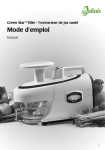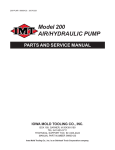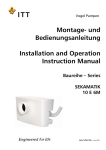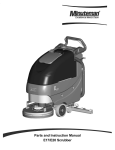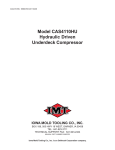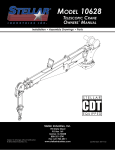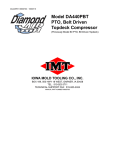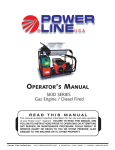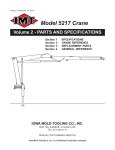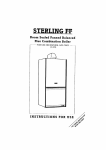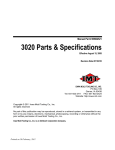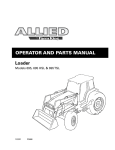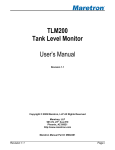Download Parts and Service Manual TIREPUMPER
Transcript
TRPR:99900388: 20070329 Parts and Service Manual TIREPUMPER IOWA MOLD TOOLING CO., INC. BOX 189, GARNER, IA 50438-0189 TEL: 641-923-3711 TECHNICAL SUPPORT FAX: 641-923-2424 MANUAL PART NUMBER 99900388 Iowa Mold Tooling Co., Inc. is an Oshkosh Truck Corporation company. TRPR:99900388: -------- REVISIONS LIST DATE 20070329 LOCATION COVER DESCRIPTION OF CHANGE UPDATED OWNERSHIP STATEMENT TRPR:99900388: 20000801 NOTES TRPR:99900388: 19951215 TABLE OF CONTENTS PARAGRAPH TITLE PAGE Section 1. OPERATION 1-1. Principle of Operation ........................................................................................... 1-1 1-2. Operation .............................................................................................................. 1-1 1-3. Mixing Solution ..................................................................................................... 1-1 1-4. Connecting the Valve Stem .................................................................................. 1-2 1-5. Removing Solution from Tires .............................................................................. 1-2 1-6. Filling Tires ........................................................................................................... 1-3 1-7. Liquid Weighting of Tractor Tires ........................................................................... 1-4 Section 2. INSTALLATION AND REPAIR 2-1. Installation Procedure ........................................................................................... 2-1 2-2. Air Supply ............................................................................................................. 2-1 2-3. Freezing or Icing of Exhaust ................................................................................. 2-1 2-4. Maintenance ......................................................................................................... 2-1 2-5. Check Valve Servicing .......................................................................................... 2-1 2-6. Pump Servicing .................................................................................................... 2-1 2-7. Troubleshooting .................................................................................................... 2-2 2-8. Recommended Lubricants .................................................................................... 2-2 Section 3. PARTS 3-1. General ................................................................................................................. 3-1 LIST OF ILLUSTRATIONS FIGURE TITLE A-1. A-2. C-1. C-2. C-3. C-4. Connecting 2-piece Valve Stem............................................................................ 1-2 Connecting 1-piece Valve Stem............................................................................ 1-2 Tirepumper Assembly (51709670) ....................................................................... 3-1 4-way Valve Assembly (70732360) ...................................................................... 3-2 Option - Air Inflation Kit (51709763) ...................................................................... 3-3 Option - Calcium Chloride Inflator (70731567) ..................................................... 3-4 PAGE LIST OF TABLES TABLE TITLE A-1. A-2. Liquid Weighting - Front Tractor Tires .................................................................... 1-4 Liquid Weighting - Rear Tractor Tires .................................................................... 1-5 PAGE TRPR:99900388: 19951215 1-1 SECTION 1. OPERATION 1-1. PRINCIPLE OF OPERATION The TIREPUMPER is a two-chambered pump driven by compressed air against a diaphragm. Each chamber is divided by a diaphragm. One side of the diaphragm is the liquid being pumped. As compressed air moves one diaphragm outward, the diaphragm in the other chamber is drawn inward by a reciprocating rod which connects the two diaphragms. As the diaphragm moves outward, it causes pressure on the liquid side of the diaphragm which evacuates that chamber. Simultaneously, the other diaphragm is creating a vacuum on the liquid side of the diaphragm which draws liquid into the other chamber. At the end of the stroke, the rod and diaphragms change direction and the chamber that just filled is evacuated. As one chamber fills, the other chamber evacuates and then the rod reverses direction. The two fluid chambers are manifolded together with a suction and discharge check valve for each chamber to maintain flow in one direction. Alternate pressurizing and exhausting of the diaphragm air chamber is performed by an air distribution valve. When the spool is at one end of the valve body, inlet air pressure is connected to one diaphragm chamber and the other diaphragm air chamber is connected to the exhaust. When the spool moves to the opposite end of the valve body, the chamber porting is reversed. 1-2. OPERATION A. The Tirepumper does not come standard with a built-in lubrication reservoir. An in-line lubricator should be installed in the compressed air line and filled with Air Lube AF anti-freeze lubricant for year around operation. No alterations should be made to the pump. B. Make sure air line to pump is free from dirt or other foreign matter. Blow out air line before attaching to pump. C. Turn on air supply to pump. CAUTION MAKE SURE AIR SUPPLY PRESSURE TO PUMP DOES NOT EXCEED 125 PSIG. The Tirepumper is supplied with a preset pressure regulator. Do not attempt to alter regulator knob or breakage will occur. Pumping volume is controlled by a color flow valve which is supplied. D. Pumping volume (gpm) can be set by counting the number of strokes per minute. The Tirepumper pumps approximately 1/10 gallon per stroke. A stroke is 1/2 cycle or one air exhaust. When pump is used for moving thick materials check stroke rate to determine that pump is not operating at a faster rate than material is capable of flowing, or cavitation will occur. If pump is operating at a speed too fast for available flow, reduce the volume of air to the pump until stroke rate approximates discharge volume (30-60 cycles per minute). If opening the color flow valve increases cycling rate without increasing the flow rate, the pump is being starved of liquid due to suction limitations. Further opening of the air inlet valve will waste compressed air. Set the inlet valve for the lowest cycling rate that meets your particular needs. 1-3. MIXING SOLUTION Prepare by pouring the calcium chloride mixture into the water (never the water into the calcium chloride, as considerable heat is generated in this mixing process). The solution should be allowed to cool to atmospheric temperature before pumping in the tire. TRPR:99900388: 19951215 1-4. CONNECTING THE VALVE STEM The following connections should be made when the pump is not running and with control handle in the check position. To connect liquid fill core ejector to 2-piece style rear tractor valves (see Figure A-1): 1-2 To connect liquid fill core ejector to 1-piece style front tractor valves (see Figure A-2): 1. Screw adapter (item A) and gasket to union (item 1). 1. Unscrew union (item 1) from core ejector body (item 2) and screw on valve stem finger tight. 2. Insert large end of core remover (item B) securely into chuck of core housing ejector (item 6). 2. Screw core ejector body on union (item 1) making certain rubber gasket (item 3) is in place, with handle (item 4) of core ejector pulled out. 3. Screw adapter and union assembly n valve stem finger tight. 3. Push handle (item 4) of core ejector in until it makes contact with the core housing of the valve, then hold the core ejector in left hand, strike the handle (item 4) with the right hand to force the core housing in ejector chuck (item 6). 4. Turn handle (item 4) to the left to unscrew the core housing, pushing inward lightly so you can feel the threads disengage when completely unscrewed. 5. Pull handle (item 4) out as far as it will go to retract core housing into ejector body. The handle will pull out easier if rotated while pulling, as packing nut (item 7) should be tight enough to prevent air or liquid leaks. 4. Screw ejector union and adapter assembly to core ejector body making sure gasket is in place. The rest of the operation is the same as with the above 2-piece valve as described above. 1-5. REMOVING SOLUTION FROM TUBETYPE OR TUBELESS TIRE Jack up tractor until tire is slightly deflected and valve is at the bottom. Connect core housing ejector and union to valve stem as previously described. Unscrew and retract core housing into ejector body with control handle at check position. Turn control handle to evacuate position and start pump. Run until tire is completely evacuated. Turn control handle to check position, stop pump and disconnect core ejector after replacing core housing in valve stem. In case of a tubeless tire, unseat beads and demount front bead from rim and pump remaining solution from tire. FIGURE A-1. FIGURE A-2. TRPR:99900388: 19951215 1-6. FILLING TUBE-TYPE OR TUBELESS TIRES WITH SOLUTION 1-3 To fill a tire 75% with water or solution: 7. Replace core housing in valve stem by pushing handle in until contact is made and turn to right until core housing is screwed tight in valve stem. 1. Inflate tire to 35 psi after beads have been fully seated in mounting procedure. 8. Withdraw handle, turn handle to evacuate, and pump all liquid from hose. 2. Jack up the wheel, if done on a tractor, and turn to bring valve to top position. 9. Shut off pump, then unscrew ejector body (item 2) and union (item 1) from valve. 3. Lower jack until tire is slightly deflected. 10. Set final working pressure after tire has been mounted on tractor with weight on tire and valve at bottom, using anair-water gauge according to tire manufacturer’s specifications. 4. With pump not running and control handle at check position, connect ejector and remove core housing as described above. 5. After connection is made, bleed pressure down to about 5 lbs. (to keep the beads seated on the rim) by moving control handle to evacuate position. 6. Start pump and move control handle to fill position. Start hydroinflating tire. Check pressure in tire every few minutes with pump gauge by placing pump in the check position. If pressure exceeds 20 psi move handle to evacuate until pressure is bled back to not less than 5 psi. After pressure is lowered, continue pumping. Repeat above steps as often as necessary to fill until water or solution weight added to the assembly is equal to that shown in the Liquid Weighting Tables. WARNING NEVER INFLATE BEYOND 35 LBS. PRESSURE. IF BEADS HAVE NOT SEATED BY THE TIME PRESSURE REACHES 35 PSI, DEFLATE THE ASSEMBLY, REPOSITION THE TIRE ON THE RIM, RE-LUBRICATE AND RE-INFLATE. AFTER SEATING BEADS, ADJUST INFLATION TO RECOMMENDED PRESSURE. ALLOWING AIR PRESSURE TO BUILD WITHIN THE ASSEMBLY IN AN ATTEMPT TO SEAT THE BEADS IS A DANGEROUS PRACTICE. IN SEATING BEADS, INFLATION BEYOND 35 POUNDS PRESSURE MAY BREAK THE BEAD (OR EVEN THE RIM) WITH EXPLOSIVE FORCE SUFFICIENT TO CAUSE SERIOUS PHYSICAL INJURY OR DEATH. INSPECT BOTH SIDES OF THE TIRE TO BE SURE BEADS ARE EVENLY SEATED. IF NOT, COMPLETELY DEFLATE TIRE, UNSEAT BEADS AND REPEAT ENTIRE MOUNTING PROCEDURE. TRPR:99900388: 19951215 1-7. LIQUID WEIGHTING OF TRACTOR TIRES The following tables provide data on the filling of front and rear tractor tires with calcium chloride solution, based on valve level or approximately 75% fill. These tables are based on the use of Type 1 - 77% commercial calcium chloride flake. If Type 2 - 94% calcium chloride flake is used, reduce the pounds/ kilograms CaCl2 weights in these tables by 25%. 1-4 Where freezing temperatures never occur, plain water can be used, but the weight added will be 20% less than calcium chloride solution. Plain water freezes solid at 32°F/0°C. Where anti-freeze protection is needed, the 3-1/2 lb/ 420g calcium chloride solution is slush free to -12°F/24°C and will freeze solid at -52°F/-47°C. The 5 lb/ 600g calcium chloride solution is slush free to -52°F/47°C and will freeze solid at -62°F/-52°C. TRPR:99900388: 19910615 1-5 TRPR:99900388: 19910615 1-6 TRPR:99900388: 19951215 2-1 SECTION 2. INSTALLATION AND REPAIR WARNING POSSIBLE EXPLOSION HAZARD CAN RESULT IF 1,1,1,-TRICHLOROETHANE, METHYLENE CHLORIDE OR OTHER HALOGENATED HYDROCARBON SOLVENTS ARE USED IN PRESSURIZED FLUID SYSTEMS HAVING ALUMINUM OR GALVANIZED WETTED PARTS. DEATH, SERIOUS BODILY INJURY OR PROPERTY DAMAGE COULD RESULT. CONSULT WITH THE FACTORY IF YOU HAVE QUESTIONS CONCERNING THE USE OF HALOGENATED HYDROCARBON SOLVENTS. 2-1. INSTALLATION PROCEDURE Position the pump as close as possible to the source of the liquid to be pumped. Avoid long or undersized suction lines and use as few fittings as necessary. At the time of installation, inspect all external fasteners for tightness. Tighten loose fittings to prevent leakage. The pump can be submerged if the materials of construction are compatible with the liquid and the exhaust is piped above the liquid level. Piping for the exhaust must not be smaller than 1". Reduced pipe size can restrict the exhausted air and reduce pump performance. If the unit is to be totally submerged, the air exhaust must be piped above liquid level to prevent the liquid and foreign material from entering the air distribution mechanism. 2-2. AIR SUPPLY Do not connect the unit to an air supply in excess of 125 PSI (8.61 bar). Install a shutoff valve in the air line to permit removal of the pump for servicing. When connecting an air supply of rigid piping, mount a section of flexible line to the pump to eliminate strain on the piping. The use of an in-line air filter is recommended. Support the weight of the air line and filter to prevent excessive weight on the pump’s air valve. Failure to comply may result in damage to the pump. 2-3. FREEZING OR ICING OF EXHAUST Icing of the air exhaust can occur under certain conditions. When pump performance suffers because of icing, be certain to use the proper lubricant as shown in the Troubleshooting section. Icing is more likely to occur at high discharge pressures. 2-4. MAINTENANCE CAUTION BEFORE MAINTENANCE OR REPAIR, SHUT OFF THE COMPRESSED AIR, BLEED THE PRESSURE AND DISCONNECT THE AIR LINE FROM THE PUMP. THE PUMP DISCHARGE LINE MAY BE PRESSURIZED AND MUST BE BLED. WHEN THE PUMP IS USED FOR TOXIC OR CAUSTIC FLUIDS, IT SHOULD BE FLUSHED CLEAN PRIOR TO DISASSEMBLY. When the pump is used for materials that tend to settle out or change state from a liquid to a solid, care must be taken after each use or during idle time to remove them and flush the pump as required to prevent damage. In freezing temperatures, the pump must be completely drained unless the liquid is resistant to freezing. After disconnecting the discharge and inlet hoses, tilt the pump to drain the fluid. 2-5. CHECK VALVE SERVICING The need for servicing is usually indicated by poor priming, unstable cycling, poor performance or the pump is cycling, but not pumping. Remove the manifold. Inspect the balls and seats for wear or damage. If pump is to prime properly, valves must be air tight. 2-6. PUMP SERVICING Refer to the “Disassembly/Reassembly Instructions” (manual part numbrer 99900503) for any repair procedures specific to the pump (IMT part number 70731387). CAUTION WEAR SAFETY GLASSES WHENEVER REPAIRS ARE BEING PERFORMED. FAILURE TO DO SO CAN RESULT IN SERIOUS INJURY. TRPR:99900388: 19951215 2-7. TROUBLESHOOTING This information is to be used as a guide to help you determine a plan of action when experiencing one or more of the following conditions. This guide should be used in conjuction with appropriate manuals which accompany the Tirepumper. The following conditions of operation are covered in this guide: 1. Fast Cycles/Low Volume 2. No Cycles 3. Leaking 4. Noise 5. Parts Breakage 6. Slow Cycles 7. Erratic Cycles These are all common conditions that may be experienced over the life of your pump. Each condition is broken down into potential causes. The causes are listed, and recommendations to correct these causes are given. Definitions for specific terms used within this guide are listed below: AIR VALVE - Brass or stainless steel housing attached to the pump center block by four bolts. PISTON - Aluminum cylinder housing within the air valve. Controls flow of air within the pump. CAVITATION - Pump is discharging less fluid than its rated capacity due to a reduction or lack of fluid supply to the pump inlet. In effect, the pump’s liquid chamber is not filled prior to discharge. STATIC DISCHARGE HEAD - The vertical distance, in feet, from the pump center line to the point of free delivery of the liquid. 2-2 INLET PRESSURES - Includes the relative weight and velocity of the fluid measured in pounds of pressure at the inlet of the pump. SPECIFIC GRAVITY - Ratio of any liquid’s weight to that of water at 62°F. Water at 62°F is said to have a specific gavity of 1.0. STATIC SUCTION LIFT - The vertical distance, in feet, from the liquid supply level to the pump centter line, the pump being above supply level. VAPOR PRESSURE - All liquids exert pressure due to formatrion of vapor at its free surface. In any pumping system the pressure at any point should never be reduced below the vapor pressure of the liquid or vapor will form causing partial or complete stoppage of liquid flow into the pump. VISCOSITY - That property which offers resistance to flow due to the existence of internal internal friction within the fluid. WATER HAMMER - The internal effects on the pump of forces placed on it by high inlet pressures or static head pressures. 2-8. RECOMMENDED LUBRICANTS The use of Air Lube AF anti-freeze lubricant is recommended (IMT Part # 89086160-QT, 89086161GAL). The following 5 WT, grade 15 lubricants may be used if performance does not suffer: EXXON - Univis N Grade 15 MOBIL - DTE 11M PENZOIL - Penzbell AWX Arctic Wt Hyd Oil SHELL - Tellus T 15 Oil TEXACO - Code 1693 Rando Oil HD 2-15 HVI TRPR:99900388: 19951215 2-3 TRPR:99900388: 19951215 2-4 TRPR:99900388: 19970106 3-1 SECTION 3. PARTS 3-1. GENERAL This section is provided as an aid in the identification, repair and ordering of parts. See the “Disassembly/ Reassembly Instructions” manual for component parts specific to the pump (IMT part number 70731387). ITEM PART NO. DESCRIPTION 1. 2. 3. 4. 5. 6. 7. 8. 9. 10. 11. 12. 13. 14. 15. PUMP VALVE ASM - 4 WAY ADAPTER 3/4MPT 3/4MPT TEE 3/4NPT RED. BUSHING 3/4 3/4NPT VACUUM GAUGE ELBOW 3/4MPT 1-5/16MJIC 90° TUBE ASM ELBOW 1"MPT 1-5/16MJIC 90° COUPLING 1"NPT STL PIPE NIPPLE 1/4NPT X CLOSE STREET ELBOW 1/4NPT 90° AIR REGULATOR PIPE PLUG 1/8NPT HOL HEX HOSE FITTING 1/4 1/4 TYPE O 70731387 70732360 72053558 72053555 72531831 70048011 72531429 70143793 72531430 72053473 72053013 72531131 70048059 72053240 72532552 QTY 1 1 1 1 1 1 1 1 1 1 2 2 1 1 4 ITEM PART NO. DESCRIPTION 16. 17. 18. 19. 20. 21. 22. 23. 24. 25. 26. 27. 28. 29. 30. HOSE 1/4 PUSH LOCK 34" COLOR-FLOW VALVE 1 MTG BRACKET - AIR CTRL 2 DECAL 1 MOUNTING PLATE 1 CAP SCR 5/16-18X1 HHGR5 3 NUT 5/16-18 LOCK 4 WASHER 5/16 WRT 4 MACH SCR #10-24X3/4 RDHD 4 NUT #10-24 LOCK 4 RUBBER BUMPER 4 DECAL-LUBRICATE PUMP 1 VALVE-SHUTOFF 1 TEE 1/4NPT STL 1 CAP SCR 5/16-18X1-1/4 HHGR5 1 89392146 73054034 52709397 70393263 60113887 72060025 72062109 72063002 72060636 72062106 76039990 70392497 73054108 72053610 72060026 FIGURE C-1. TIREPUMPER ASSEMBLY (51709670) QTY TRPR:99900388: 19910615 ITEM PART NO. DESCRIPTION 1. 2. 3. 4. 5. 6. 7. 8. 9. 10. 11. 12. 13. 14. 15. BODY ROTOR 3/4 BRASS CAP HANDLE WASHER 1/4 WRT CAP SCR 1/4-20X1/2 HH GR5 CAP SCR 1/4-20X5/8 HH GR5 SEAL-PORTED (PART OF 15) O-RING (PART OF 15) O-RING (PART OF 15) WASHER-BTM(PART OF 15) WASHER-TOP(PART OF 15) O-RING (PART OF 15) O-RING (PART OF 15) REPAIR KIT (INCL:8-14) 70143877 77041434 70143878 70143879 72063001 72062000 72060001 76393362 76393365 76393364 70143881 70143880 76393366 76393363 51393264 3-2 QTY 1 1 1 1 1 1 4 4REF 1REF 1REF 1REF 1REF 1REF 4REF 1 FIGURE C-2. 4-WAY VALVE ASSEMBLY (70732360) TRPR:99900388: 19960925 3-3 ITEM PART NO. DESCRIPTION 1. 2. 3. 4. 5. 6. 7. 8. 9. 10. 11. 12. ADAPTER 1/2MPT X 1/2MPT 1 BARB NIPPLE 1/2MPTX1/2BARB 2 TEE 3/5NPT 1 ADAPTER 3/4MPT X 3/4MPT 1 ST ELBOW 1/2NPT BRS 90° 1 TEE 1/2NPT BRS 1 ADAPTER 3/4MPT 1/2MPT HEX 1 HOSE CLAMP SAE#12 2 BALL VALVE 1/2NPT 1 IN-LINE CHECK VALVE 1/2FPT 1 AIR HOSE 1/2 RED 250PSI 24" ST ELBOW 1/4NPT BRS 90° 1 72053725 72053457 72053555 72053558 72053591 72531961 72053726 72066004 73054192 73054676 89039176 72053523 QTY FIGURE C-3. OPTION - AIR INFLATION KIT (51709763) TRPR:99900388: 19910615 3-4 TO OPERATE: 1. Position wheel so valve is at top. 2. Remove valve cap and loosen valve core housing before attaching inflator to valve. NOTE To service standard bore valves, assemble nose adapter to inflator. This adapter has a rubber gasket for sealing against rim nut. Do not use nose adapter when servicing super large bore valves TR F900, TR F910, TR F910B and TR F916. Connect inflator to valve mouth and rotate knurled swivel nut to engage threads. Tighten nut until valve hits stop in inflator. Tighten by hand only! 3. Engage knurls on core housing with collet by pushing knob forward and tapping lightly with hand. 4. Turn knob counterclockwise to remove core housing from valve. 5. Retract knob assembly completely to rear of inflator to disengage core housing. 6. Start liquid filling. When tire appears to be fully inflated, rotate the valve handle to the CHECK position to bleed trapped air from the tire. Continue filling in this manner until the tire is properly filled. 7. Shut off pump. Insert core housing into valve stem by pushing knob assembly forward and turning clockwise until the core is fully engaged. 8. Disengage collet from core housing by pulling knob assembly firmly toward the rear of the inflator. 9. Unscrew the inflator from the valve stem. 10. Tighten the valve core securely. 11. Check the tire pressure and top-off as necessary.Use standard air gauge and chuck. ITEM PART NO. DESCRIPTION 1. 2. 3. 4. 5. 6. 7. 8. 9. 10. 11. 12. 13. 14. 15. 16. 17. 18. 19. 20. 21. 22. 76392292 70024285 7Q072016 70024286 76392293 76392294 70024287 70142699 72066618 70142700 7Q072014 70024288 7Q072011 70024289 72066618 70024290 7Q072006 70024291 70024323 76392421 70142864 51392295 23. 24. 25. 26. 70024307 70024321 70731625 70024322 RUBBER WASHER 13/16 1 ADAPTER-TRACTOR & LG BORE 1 O-RING (PART OF 4) 1 INFLATOR SUB-ASM(INCL:3,5-7) 1 RUBBER WSHR 3/4(PART OF 4) 1 LENS (PART OF 4) 1 SOCKET NUT (PART OF 4) 1 COLLET (PART OF 25) 1 LOCK PIN (PART OF 25) 1 ROD (PART OF 25) 1 O-RING (PART OF 25) 1 HOUSING CAP (PART OF 25) 1 O-RING (PART OF 25) 1 O-RING RETAINER(PART OF 25) 1 LOCK PIN (PART OF 25) 1 KNOB (PART OF 25) 1 O-RING 1 PLUG 1 ADAPTER-STD TIRE VALVE 1 RUBBER WASHER 3/4 1 CORE EXTRACTOR 1 REPAIR KIT (INCL:1,3,9,13,15,17,20) REF ADPTER W/WASHER(INCL:1&2) REF PLUG W/O O-RING(INCL:17&18) REF KIT (INCL:8-16) REF ADAPTER W/WASHER (INCL:19 & 20) REF EXTRACTOR KIT(INCL:19,20,21)REF 27. 70731694 FIGURE C-4. OPTION - CALCIUM CHLORIDE TIRE INFLATOR (70731567) QTY TRPR:99900388: 19910615 TRPR:99900388: 20000707 This parts manual is provided to the user to assist in servicing the equipment. It is the propertyof Iowa Mold Tooling Co., Inc and, as such, may not be reproduced either whole or in part,whether by chemical, electrostatic, mechanical or photographic means without the expressedwritten permission of an officer of Iowa Mold Tooling Co., Inc. One manual is provided with each piece of new equipment and additional manuals may be obtained at a nominal price. IOWA MOLD TOOLING CO., INC. BOX 189, GARNER, IA 50438-0189 TEL: 641-923-3711 TECHNICAL SUPPORT FAX: 641-923-2424





















